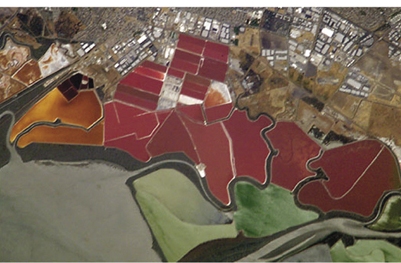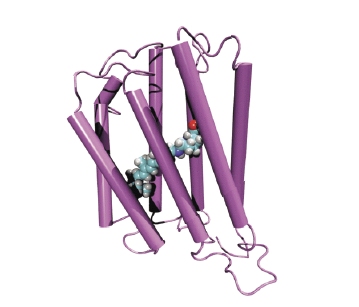
Nature may be the ultimate designer, using evolution to precisely engineer each biological component to fit a unique function. So the discovery by a team of Weizmann Institute scientists that a protein in a cell wall excels at a function it apparently never performs in living organisms - conducting electricity - was as surprising as finding that hooking up a keyboard could turn a washing machine into a computer.
Prof. Mordechai Sheves, Dean of the Institute's Faculty of Chemistry, Prof. David Cahen of the Materials and Interfaces department, and Drs. Yongdong Jin and Noga Friedman of the Organic Chemistry Department, made their discovery in a series of experiments on a membrane protein isolated from a salt-water microorganism that, like plants, uses sunlight for energy. This protein, known as bacteriorhodopsin (or bR for short), captures the sunlight, which is converted inside the cell to chemical energy for storage. When sunlight hits the protein, protons are ejected and pumped across the cell membrane to energy conversion machinery on the other side. Our eyes contain similar proteins, rhodopsins, which also capture light but convert it to optic nerve signals rather than energy. Both bacterial and mammalian proteins contain a segment called retinal, a vitamin A derivative needed for eyesight.
Distinguished by its deep purple color, bR changes to yellow following light absorption. Sheves and Cahen found this protein an ideal subject both because of its light activity and because of its unusual stability. Since it has been extensively studied, they had access to a vast fund of knowledge on the protein's structure and function, allowing them to manipulate various parts in their experiments.
Their findings showed that bR can pass a current that is tens of thousands of times stronger than that which would be expected to pass through a protein - the difference is comparable to that between a room heater on at full blast and the electricity used by the little red LED on the side that tells you the heater's on. The retinal portion of the protein turned out to be a crucial component for passing current.
The scientists found that the electron transfer is affected by light absorption. The protein's ability to capture sunlight activates a chemical switch: A retinal double bond changes the molecule's shape, flipping a part of the molecule from one side of the bond to the other. After this switchover takes place, the ability of the protein to pass current improves twofold. When the scientists carefully substituted a different molecule for the retinal segment - one that can't undergo the chemical change wrought by light absorption - the photosensitive effect was gone.
The study raises interesting questions about evolution, says Sheves: "Why would nature create and maintain such an efficient system for conducting electricity, and then not use it? Is it simply an accident of biology, or did evolution abandon electron transport early on in favor of other kinds of energy? And if so, why?"
Prof. Mordechai Sheves's research is supported by the Helen and Milton A. Kimmelman Center for Biomolecular Structure and Assembly; the Joseph and Ceil Mazer Center for Structural Biology; the A.M.N. Fund for the Promotion of Science, Culture and Arts in Israel; Samuel T. Cramer, Beverly Hills, CA; and the estate of Klara and Max Seidman, Israel. Prof. Sheves is the incumbent of the Ephraim Katzir-Rao Makineni Professorial Chair in Chemistry.


